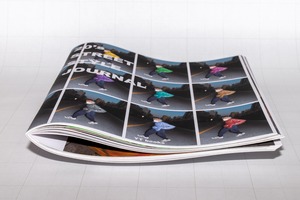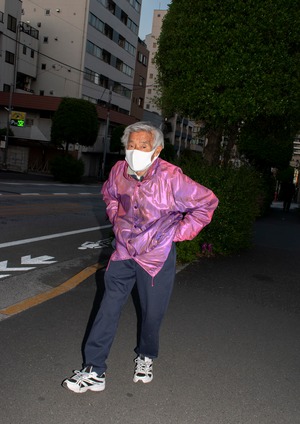

20's STREET STYLE JOURNAL #1
#1 NOT PLASTIC FASHION
PHOTO BY @yutarosaito + TEXT BY @72yearsold
152 PAGES
225mm x 300mm
150 COPIES
※可塑性によりページ構成は一点一点異なります
プラスチックファッションとは昨今のモードを揶揄した言葉です。昨今のモードのプロモーションはSNSもっぱらインスタグラムが主流となっていますが、そこではロゴやアイコニックなグラフィック、コラボレーションなどスマートフォンの小さな画面でもブランドの主張が映えるものがプロモーションされ、また消費者もそれらを好む傾向にあります。そういった消費はいわゆるブランドの記号的側面の消費であり、モードの本質とは本来袖を通した時に分かる仕立ての良さや素材など画面の向こうにある物質的なものです。記号そのものには価値はなく、ブランドの記号とは本来本質的価値の上に存在するものですが、現状は本質を無視した記号消費がモード・消費者共にSNSやウェブ上のデジタル空間において加速している状況です。一方、プラスチックは戦後の大量消費社会に対応すべく実用化された素材でそれそのものに価値はありません。現在身の回りのあらゆるものはプラスチックに包まれ他製品と差別化するカラーリング、ブランドロゴ、キャッチフレーズ、宣伝広告などあらゆる記号的価値を付随させ「価値あるモノ」として演出されています。そのように、価値のないモノを価値があるように演出し記号化していく特性がプラスチックと現在のモードの共通項なのです。
プラスチックファッションを定義づけた上でファッションスタイルの話になりますが、私は上述したようなプラスチックファッションはカッコよくないと考えています。なぜならプラスチックファッションを選ぶ人々の判断基準は、おしゃれ、流行、あの人のようになりたい、モテたいなど「他者へのベクトル」が向いたファッションだからです。そのようなファッションは本人自身との繋がりが薄く、その人独自のスタイルであるとは言えません。では逆にどのようなスタイルがその人自身とのつながりが強いかというと、つまりは「自己へのベクトル」が向いたファッションです。例えばアシックスのスニーカーで例えると、モードやストリートブランドがコラボしているからアシックス=おしゃれという記号の元に判断し購入する場合と、早朝にランニングしたいからとアシックスのスニーカーを購入する場合で自己へのベクトルが向いているのは後者です。流行やおしゃれへの意識はつまるところそれを評価する他者の存在で成り立つものであり、そのファッションの選択基準は他者に属していると言えます。一方で後者の例は自身の走りたいという欲求に則ったファッションであり選択基準は自己にあります。そのような「自己へのベクトル」が向いた選択を積み重ねることでファッションと自身のパーソナリティ・趣味趣向・ライフスタイルがリンクし、その人とファッションの繋がりが強くなりスタイルとしての魅力も増すと私は考えています。
では「自己へのベクトル」が向いたファッション、これを体現している人は誰なのかと考えた時に私は年齢を一つの判断基準とすることにしました。10代~30代では異性からの目線、自身のアピール、流行など「他者へのベクトル」を意識したファッションが多く、40、50代でもそれらの傾向は少なくありません。一方で60、70、80代と年齢を重ねるごとにそのような意識は薄くなり、どんどん自己へとベクトルが向いていく傾向にあります。それは年齢的に他者の目線や異性への意識より、自分の生活のしやすい服や趣味に通じた服を好む傾向にあるからです。彼らのスタイルは若者のファッションよりもパーソナリティが表出しており、モードの記号にとらわれないオリジナルなファッションなのではないかと考えています。
The word "plastic fashion" is a caricature of recent modes. The recent modes have been promoted mainly on Instagram, where brand logos and iconic graphics that are eye-catching on screens tend to be used, and consumers prefer those things too. In other words, consumption of such items is consumption of the symbolic aspect of mode. The essence of a mode lies on the actual materialistic value beyond the screens such as well-tailored and high quality material. Symbols themselves have no value, and a symbol of brand, in essence, resides on its substantial value. However, seeing the status quo, symbolic consumption with no regard to this essence is accelerating on digital space, such as websites and Instagram. Incidentally, plastic was put in practical use answering the demand of mass consumption societies after WWⅡ; and yet plastic itself has no value. Nowadays, almost everything around us is covered with plastic, while displaying things as something valuable by attaching symbolic values with the use of vivid coloring, brand logos, catchphrases and advertising, to differentiate themselves from other products. In such a manner, recent mode and plastic have something in common, in a way that they have characteristics of displaying and symbolizing things of no value as things of value.
Regarding fashion styles, having defined plastic fashion, I do not think plastic fashion as mentioned above is cool or elegant. That is because the evaluation criteria of people choosing plastic fashion is "other-oriented”, such as desire to be fashionable and trendy, to follow a mode, to be an icon, or to be popular. Such a fashion style has an identically distant relationship with its wearers, meaning it does not represent their original style. Then, what is a fashion style that represents who the wearers are? I believe it is the one that is “self-oriented.” Take ASICS's running shoes as an example. The fashion style is “other-oriented” when you choose ASICS based on its symbol; shoes the company provides are ‘cool’ because it is, say, running a collaboration campaign with a recent mode or street brand. On the other hand, it is “self-oriented” when you choose ASICS because you simply want to go for a jog in the early morning. Awareness of mode and trend is, after all, based on the existence of others who evaluate it, and it can be said that the selection criteria for fashion belong to others. The latter example shows a fashion style chosen simply to meet the desire to run, and the selection criteria are based on a self. With the accumulation of choices of such “self-oriented" fashion styles, I think the fashion will be linked with one's personality, hobbies and lifestyle and the style will become more attractive.
Then, when I thought about who embodies "self-oriented" fashion, I decided to use an age as one of the criteria. From teens to 30s, there tend to be many fashion styles that are "other-oriented conscious”, such as desire to attract opposite sex and their own appeal, and even in 40s and 50s, this tendency can be commonly seen. On the other hand, as people become older, after their 60s, such consciousness becomes weaker, and people tend to become more and more “self-oriented”. That is because these people tend to prefer clothes that are easier to put on or that match with their hobbies, rather than being concerned about the eyes of others and the opposite sex. Their style is more personal than youth fashion, and I think it is more of an original fashion unbound by any mode symbols.
November 24th, 2021

